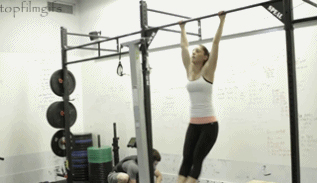More Than You Ever Wanted to Know About the Kipping Pull-up
by Erik Castiglione
Kipping pull-ups – the uniquely CrossFit movement that non-CrossFitters love to hate. What are they? No, they’re not cheating pull-ups, non-pull-ups, or sissy pull-ups. Very simply, they are a pull-up variation in which a controlled opening and closing of the hips allows us to generate some momentum to propel ourselves over the bar.
Where does the kip come from? It’s derived from what gymnasts call a “glide kip.” In gymnastics, however, the glide kip isn’t really a movement; it’s how gymnasts get over the bar so that they can do other movements in their routine. The glide kip is incredibly efficient when mastered. So much so, that it’s illegal in CrossFit competitions as a muscle-up variation.
Why do people hate on them? Well, to the uninitiated, a kipping pull-up seems like it’s cheating. It looks easier, because we get to use momentum. To the more physical therapy oriented, the kipping pull-up is often blamed as a cause of shoulder issues. Some PT’s claim that they cause too much wear and tear on the joint and should be avoided at all costs.
Is it cheating? NO. The kipping pull-up is simply a different movement from the strict variation. In the strict version, we’re limited by muscular strength and stamina, and the muscles involved are limited to the upper body. We call this a “local movement”, and when you fatigue, it’s what we call “local fatigue.” When we add in a kip, it shifts the load from the upper body to the whole body. This turns it into what we call a “global movement”, which adds a cardiovascular component to the movement. This is why a set of 10 kipping pull-ups can spike your heart rate a lot higher than a set of 10 strict pull-ups. When you get tired in a workout with kipping pull-ups, it’s what we call “systemic fatigue.” It’s the same if we look at a strict press vs. a push press. In a strict press for reps, it’s likely that your arms will fatigue first (local fatigue). In a push press, you’re usually limited by your wind (systemic fatigue). In both cases, no movement involves cheating; it’s just a different movement.
Is the kipping pull-up dangerous for the shoulder? Well, like most movements, it depends. If you have the strength to do several strict pull-ups, and the shoulder mobility and stability to pass through the full range of motion in a kip, then you can safely control the movement, and it’s perfectly fine. However, if you put the cart before the horse and crank out hundreds of kipping pull-ups before you’re able to do strict pull-ups, you may not have the proper stability or control to perform them safely, and yes, you have a greater risk of getting hurt. I’ve been coaching CrossFit for 10 years now, and I’ve encountered only 2 cases of members tearing their shoulders while kipping their pull-ups. In both instances, the athletes were members joining my gym POST INJURY. And, in both instances, the athlete performed the benchmark WOD “Angie” (100 pull-ups, 100 push-ups, 100 sit-ups, 100 squats, done for time) as Rx’d, and neither could do a single strict pull-up. Therefore, we encourage all our athletes to perform strict pull-ups before kipping.
What are the other benefits of a kipping pull-up? We already mentioned the cardiovascular benefit of performing them. You still get to work the muscles of your upper back, but to a lesser extent than the strict variations. The coordination you learn in the kipping pull-up can also be applied to other movements: toes to bar, chest to bar pull-ups, and eventually, muscle-ups. Finally, since most of your body is floating in the air during the movement, it’s great for developing kinesthetic awareness.
Why do we have scale with both jumping pull-ups and banded strict pull-ups? Well, it depends on the goal of the workout. When the limiting factor of the workout is stamina, like in “Angie” or “Murph”, strict pull-ups (with bands added) are the better scaling option. When the limiting factor is your motor, as in “Fran”, jumping pull-ups are more appropriate.
I hope you found this helpful and learned more than you ever wanted to know about the kipping pull-up. Questions? Sound off in the comments section.


